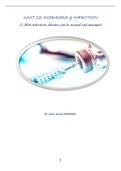Essay
BTEC Applied Science Unit 12 Assignment C
- Course
- Institution
This is the 3rd Assignment for Unit 12 of BTEC Applied Science. This was awarded a DISTINCTION. It’s in Word format and is referenced in Harvard style. I hope it’s helpful for you coursework
[Show more]



